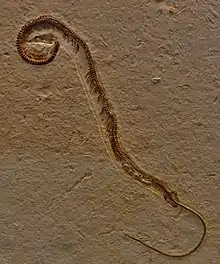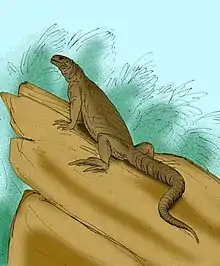Tetrapodophis
Tetrapodophis (Greek meaning "four-footed snake") is an extinct genus of lizard from the Early Cretaceous (Aptian) aged Crato Formation of Brazil. It has an elongate snake-like body, with four limbs. Tetrapodophis has been considered by some authors to be one of the oldest members of Ophidia (snakes and their extinct relatives).[1][2][3] However, this classification has been disputed by some other authors,[4][5][6] who identify Tetrapodophis as a dolichosaurid much less closely related to snakes.
| Tetrapodophis Temporal range: Early Cretaceous | |
|---|---|
 | |
| Fossil in Bürgermeister-Müller-Museum | |
| Scientific classification | |
| Domain: | Eukaryota |
| Kingdom: | Animalia |
| Phylum: | Chordata |
| Class: | Reptilia |
| Order: | Squamata |
| Family: | †Dolichosauridae |
| Genus: | †Tetrapodophis Martill et al., 2015 |
| Type species | |
| †Tetrapodophis amplectus Martill et al., 2015 | |
Description

Tetrapodophis possesses small yet well-developed fore- and hindlimbs like a lizard and a long body similar to a snake, around 19.5 cm (7.7 in) in length.[6] Nevertheless, it shares many characteristics with modern snakes, including an elongate body, short tail, broad belly scales, a skull with a short snout and long braincase, curved jaws, and sharp hooked teeth. BMMS BK 2-2 contains bones of another animal in its gut, indicating that Tetrapodophis was carnivorous like most snakes but it turns out to be a lizard. Other features such as short neural spines suggest that Tetrapodophis was adapted to burrowing, lending support to the hypothesis that snakes evolved in terrestrial environments (another hypothesis posits that they evolved in aquatic environments).[2] The high number of vertebrae (upwards of 150) in Tetrapodophis and snakes is not seen in other burrowing reptiles with elongate bodies and reduced or absent limbs, meaning that it is most likely not an adaptation for a serpentine form of movement.[1] Dolichosaurids are thought to be phylogenetically close to snakes as members of Ophidiomorpha, which explains some of the morphological similarities.
Discovery
The type species, Tetrapodophis amplectus, was named in 2015 on the basis of a complete skeleton (BMMS BK 2-2) preserved on a limestone slab in the Bürgermeister Müller Museum in Solnhofen, Germany, which was labeled as "unknown fossil" until its importance was recognized by paleontologist David Martill.
Classification
A phylogenetic analysis published alongside the original 2015 description of Tetrapodophis places it as a close relative of other lizards, but outside the crown group Serpentes, meaning that tetrapodophis branched off before the most recent common ancestor of all living snakes. Below is a cladogram from that analysis:[1]
| Squamata |
| |||||||||||||||||||||||||||||||||||||||||||||||||||||||||||||||||||||
The interpretation of Tetrapodophis amplectus as an early fossorial snake was challenged by Caldwell et al. (2016), who considered it more likely to be a dolichosaurid squamate related to mosasaurs.[4][7] A position supported by later analysis in 2018[5] and in 2021.[6] However, a study in 2023 again supported its position as a stem-snake, finding it to be unrelated to mosasaurs.[3]
Related articles
- Ophidia
- Pythonomorpha, including dolichosaurs, snakes and mosasaurs
- Coniophis
- Paleontology
- Najash rionegrina
- Dinilysia patagonica
References
- David M. Martill; Helmut Tischlinger; Nicholas R. Longrich (2015). "A four-legged snake from the Early Cretaceous of Gondwana". Science. 349 (6246): 416–419. doi:10.1126/science.aaa9208. PMID 26206932. S2CID 25822461.
- Lee, Michael S. Y.; Palci, Alessandro; Jones, Marc E. H.; Caldwell, Michael W.; Holmes, James D.; Reisz, Robert R. (1 November 2016). "Aquatic adaptations in the four limbs of the snake-like reptile Tetrapodophis from the Lower Cretaceous of Brazil". Cretaceous Research. 66: 194–199. doi:10.1016/j.cretres.2016.06.004. ISSN 0195-6671.
- Zaher, Hussam; Mohabey, Dhananjay M; Grazziotin, Felipe G; Wilson Mantilla, Jeffrey A (28 February 2023). "The skull of Sanajeh indicus , a Cretaceous snake with an upper temporal bar, and the origin of ophidian wide-gaped feeding". Zoological Journal of the Linnean Society. 197 (3): 656–697. doi:10.1093/zoolinnean/zlac001. ISSN 0024-4082.
- Michael W. Caldwell; Robert R. Reisz; Randall L. Nydam; Alessandro Palci; Tiago R. Simões (2016). "Tetrapodophis amplectus (Crato Formation, Lower Cretaceous, Brazil) is not a snake". Society of Vertebrate Paleontology 76th Annual Meeting Program & Abstracts: 108.
- Paparella, Ilaria; Palci, Alessandro; Nicosia, Umberto; Caldwell, Michael W. (June 2018). "A new fossil marine lizard with soft tissues from the Late Cretaceous of southern Italy". Royal Society Open Science. 5 (6): 172411. doi:10.1098/rsos.172411. ISSN 2054-5703. PMC 6030324. PMID 30110414.
- Michael W. Caldwell; Tiago R. Simões; Alessandro Palci; Fernando F. Garberoglio; Robert R. Reisz; Michael S. Y. Lee; Randall L. Nydam (2021). "Tetrapodophis amplectus is not a snake: re-assessment of the osteology, phylogeny and functional morphology of an Early Cretaceous dolichosaurid lizard". Society of Vertebrate Paleontology, Latest Articles. 19 (13): 893–952. doi:10.1080/14772019.2021.1983044. S2CID 244414151.
- Geggel, Laura (28 October 2016). "Mistaken Identity? Debate Over Ancient 4-Legged Snake Heats Up". Live Science.
External links
 Media related to Tetrapodophis at Wikimedia Commons
Media related to Tetrapodophis at Wikimedia Commons- Tetrapodophis as it may have been in life
- Scientists Discover Four-Legged Snake Fossil. On: SciTechDaily, Source: University of Portsmouth. 2 August 2015
- Susan Evans: “Four legs too many?," In: Science Vol. 349 no. 6246 pp. 374–375. 24 July 2015; doi:10.1126/science.aac5672
